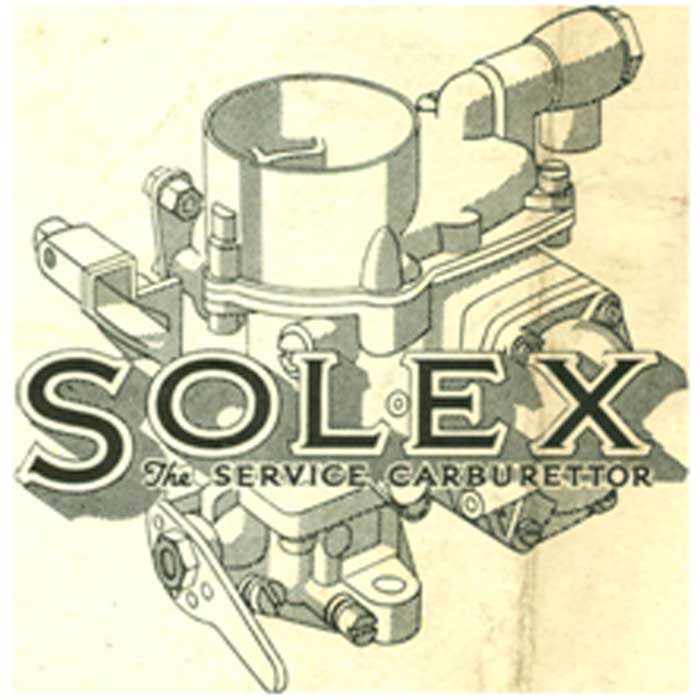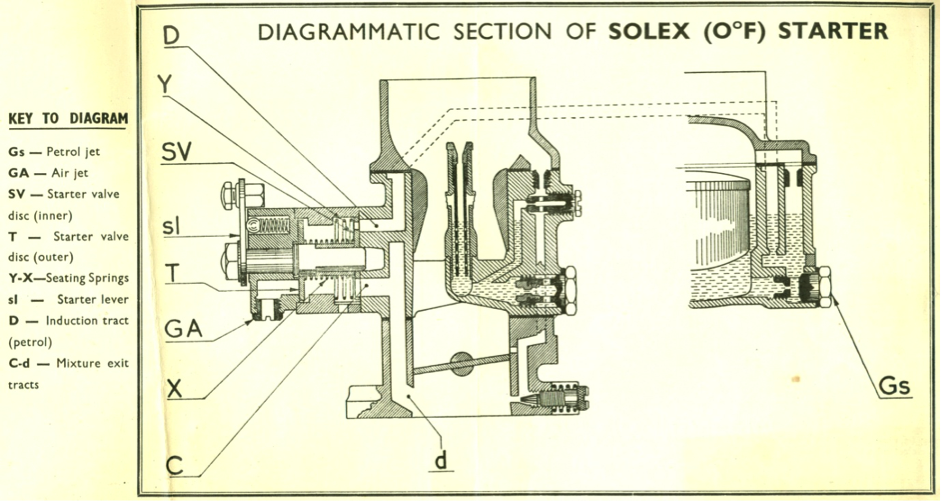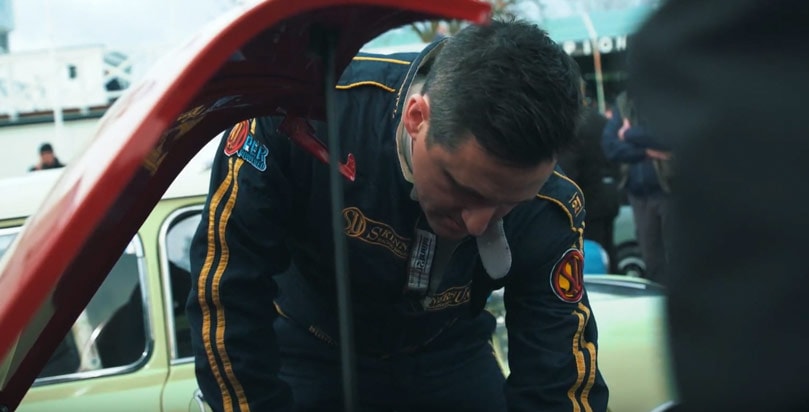
ZERO (0°F) STARTER
The Zero Starter unit for Solex carburettors is designed for incorporation with certain Solex carburettors, fitted to vehicles which have a market in countries where very Iow temperatures prevail during the Winter months. Its function is similar to that of the well-known Solex "Self-Starter," and it is operated in exactly the same way, i.e., as follows:
TO START THE ENGINE FROM COLD, PRIOR TO CLOSING THE ELECTRIC STARTING CIRCUIT:
- Pull out fully the dashboard control. Then start the engine, and
- Push the control half-way in (a marked resistance will be felt in this position) immediately the engine has “got a grip”
- Push fully home when the engine is warm enough to idle and accelerate without the aid of the "starter" unit.
NOTE: If at extremely low temperatures the dashboard control must be kept in the No, 1 position for more than a few seconds to avoid stalling, the foot throttle should be gently depressed to admit more air to dilute the rich mixture and assist in warming up the engine in order that No. 2 position of the dashboard control can be achieved as quickly as possible.
In normal and warm climates, the engine can generally be started with the dashboard control in No. 2 (half-way) position. It can easily be understood how the Zero Starter functions by studying the diagram, which exemplifies this unit applied to the Solex Downdraught carburettor.
The central shaft to which the lever (sI) is affixed has pinioned to it, at the inner end, a disc valve (SV). At the other end is another disc valve (T), fitted so that it can slide along the shaft within the limit of its housing in the casting body.

When the dashboard control, which is linked up with the lever (sI), is pulled out fully the shaft rotates, and the disc (SV), having suitably located holes drilled through, takes up a position where these holes register. with the channels (D) and (C), the spring (Y) holding the disc firmly in this position.
The disc (T), though suitably drilled, presents a blank outer face to atmosphere, the spring (X) holding it in position against the outer face. of its housing.
All is now in readiness to start the engine. On closing the electrical circuit, and with the throttle butterfly closed, as shown in the diagram, engine depression, or suction, takes ·effect at the outlet channel (d), and is transmitted to the starter mixing chamber in which are located.
Meantime, the suction acting on the surface of the disc (T). draws it inwards against the pre-determined strength of the spring (X). and admits air via the jet (GA), restricted, however, by the space forming a clearance between the disc and its original seating.
By this means it will be seen that a very rich mixture (in the neighbourhood of 1 : 1 air/petrol) is provided for cold starting. In consequence, the dashbard control must be pushed into the No. 2, i.e .bi-starter position as soon as possible.
With this procedure, a hole in the disc (T) registers with the outer exit of the channel (C), so allowing free passage of air to the full capacity of the air jet (GA). At the same time, the disc (SV) has, in its new position, presented a smaller hole to the channel (D), thereby reducing the quantity of petrol entering the mixing chamber.
A much weaker mixture is therefore inspired by the engine, which may be left to warm up if desired, though it is preferable to drive off at reasonable speed, thus putting the fuel consumption to good use. After a few minutes running, the engine will be warm enough to function satisfactorily without the aid of the starter unit, when the dashboard control must be pushed right home, thus putting the starter unit out of action.
POINTS TO NOTE:
- Use the bi-starter (half-way) position to start the engine unless the temperature is very low, and keep the throttle closed to the minimum idling position.
- If the full rich mixture must be used to start, return the dashboard control to the bi-starter position as quickly as possible.
SPECIAL NOTE
The growth in popularity overseas of British cars depends in some countries upon the ease with which they can be started from cold at very low temperatures In Canada for instance, 400 or more below freezing point is not unusual in the winter. The "O°F starter” which this leaflet describes will, so far as carburation is concerned, provide the correct mixture for starting in a few seconds at such temperatures, if the instructions are closely followed. It is to be emphasised that starting from cold if a Solex is correctly "set" to suit the engine, should never present any difficulty, but it is important to make sure that all the following details are in order:
- Battery well charged. If the voltage is low, all the energy may be absorbed by the electric starter leaving none to provide a spark at the plug electrodes.
- Sump Oil. The grades recommended by the makers of the car should be used according to the season.
- Condition and Spacing of the contact breaker points in the distributor head is most important.
- Plugs must be ill good condition. A "short" high up in the body will prevent easy starting and, furthermore, produce all the functional effects of retarded ignition timing, with consequent heavy fuel consumption. The Plug points should be kept clean and spaced in accordance with the engine maker’s recommendation.
- Tappet adjustment is often too long neglected. A check every 5,000 miles is well worth while.
- Valves mostly have a good life, but every 5,000 miles turn the engine over by hand. Weak compression in one or more cylinders means that the valves require attention. Remember that where the compression can escape, air in an unknown quantity can leak in and this will, if neglected, cause difficult starting and other troubles.





